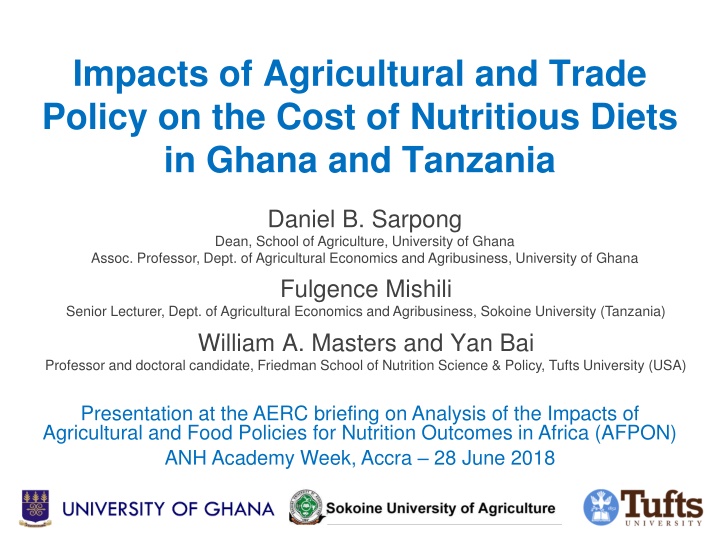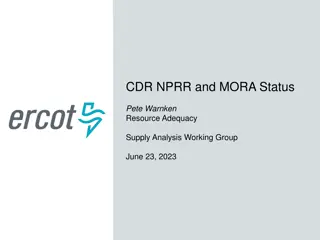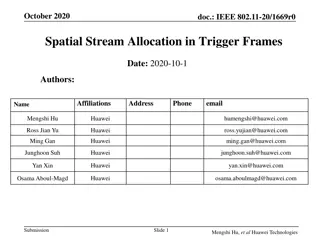Default Uplift Allocation Methodologies in ERCOT
This content explores alternative default uplift methodologies in ERCOT, including comparisons with PJM methodology, adjustments made for estimates, and the current allocation method as of January 2021. It delves into the allocation formula, analysis requests, and adjustments for simplification and cost reduction in the system.
Download Presentation

Please find below an Image/Link to download the presentation.
The content on the website is provided AS IS for your information and personal use only. It may not be sold, licensed, or shared on other websites without obtaining consent from the author.If you encounter any issues during the download, it is possible that the publisher has removed the file from their server.
You are allowed to download the files provided on this website for personal or commercial use, subject to the condition that they are used lawfully. All files are the property of their respective owners.
The content on the website is provided AS IS for your information and personal use only. It may not be sold, licensed, or shared on other websites without obtaining consent from the author.
E N D
Presentation Transcript
Impacts of Agricultural and Trade Policy on the Cost of Nutritious Diets in Ghana and Tanzania Daniel B. Sarpong Dean, School of Agriculture, University of Ghana Assoc. Professor, Dept. of Agricultural Economics and Agribusiness, University of Ghana Fulgence Mishili Senior Lecturer, Dept. of Agricultural Economics and Agribusiness, Sokoine University (Tanzania) William A. Masters and Yan Bai Professor and doctoral candidate, Friedman School of Nutrition Science & Policy, Tufts University (USA) Presentation at the AERC briefing on Analysis of the Impacts of Agricultural and Food Policies for Nutrition Outcomes in Africa (AFPON) ANH Academy Week, Accra 28 June 2018
Impacts of Agricultural and Trade Policy on the Cost of Nutritious Diets in Ghana and Tanzania Motivation | data & method | policy analysis & results | conclusions How do agricultural production and market policies affect the affordability of nutritious diets? To answer, we need to know more than average food prices; we need to count foods in terms of their nutritional value How might we measure the affordability of a nutritious diet? Can we use these measures in practice, given available data? Previous projects (IANDA/CANDASA) offer a set of metrics to help answer these questions Pilot in Ghana and Tanzania, with academic partners Local stakeholder workshops with government & NGO officials Application to AFPON shows clear potential for policy analysis Specific formulas & results for a wide variety of applications Results here contrast policies for ag production (e.g. PFJ in Ghana) vs. policies to improve markets (e.g. trade policy in Tanzania)
Impacts of Agricultural and Trade Policy on the Cost of Nutritious Diets in Ghana and Tanzania Motivation | data & method | policy analysis & results | conclusions To measure the cost of a nutritious diet, we need new indicators Existing measures count foods consumed based on their monetary value only, without reference to nutritional quality FAO & other World Food Price Indexes reflect quantities traded on world markets Each country s national Consumer Price Indexes reflect the cost of foods currently consumed by specific population Neither reflects the healthy diets promoted by many policies/programs We introduce price indexes corresponding to each nutritional standard, such as diet diversity and recommended diets For policy analysis, here focus on Cost of Nutrient Adequacy (CoNA): the least-cost combination of foods to meet nutrient requirements CoNA provides a lower bound on cost of a healthy diet We test how different policies alter those costs in Ghana & Tanzania
Impacts of Agricultural and Trade Policy on the Cost of Nutritious Diets in Ghana and Tanzania Motivation | data & method | policy analysis & results | conclusions The Cost of Nutrient Adequacy is a lower bound on affordability of nutrients at each time and place The CoNA price index is the least-cost diet at each market, returning the minimum cost of buying enough nutrients for an average adult woman each day: min. Ckt = ipiqi subject to inijqi EARi and inieqi E CoNA depends on the quantity of each food (qi) chosen based on its price (pi), its density in nutrient j (nij), and the woman s estimated average requirement (EARj) for that nutrient, plus energy balance at daily level E Variation in CoNA comes from variation in prices, as measured for a market information system or inflation statistics
Impacts of Agricultural and Trade Policy on the Cost of Nutritious Diets in Ghana and Tanzania Motivation | data & method | policy analysis & results | conclusions Food prices can come from many different sources How are food prices now being collected and used? Market information & price monitoring National accounts & poverty monitoring Agricultural & food agencies Financial & statistical agencies Actor Ghana MoFA enumerator collecting food price data Inform farmers, traders, distributors Measure real income, inflation, poverty Purpose Traded commodities, often a few key staple foods and cash crops at wholesale markets Retail products, often a long list of over 50 standardized items from urban supermarkets Products Individual prices may be available upon request; Private sources charge for subscriptions Aggregate indexes reported annually, quarterly or monthly; Item-level prices are sometimes confidential Access Photo: Anna Herforth, 2017
Impacts of Agricultural and Trade Policy on the Cost of Nutritious Diets in Ghana and Tanzania Motivation | data & method | policy analysis & results | conclusions The IANDA project helped Ghana MoFA expand price data collection to include more diverse foods White Roots and Tubers Yam Cocoyam Dark Green Leafy Vegetables Cereals Maize Millet Sorghum Cassava Rice Plantain Pulses Plantain Cowpea (white) Groundnut (unsh) Nkontommire Soya bean Groundnut (red) Bambara Bean Melon Seeds Nuts and Seeds Seed Oil Coconut oil Palm oil Groundnut oil Jute mallow Alefu (Amaranthus) Gari Sweet potato Cassava dough Dried cassava Meat, Poultry and Fish Beef Pork Salted dried fish Live chicken bird Smoked herring Anchovy Fresh fish Chicken meat Snail Goat meat Mutton Vegetables Tomato Garden Egg Okro Onion Ginger Pepper Cabbage Lettuce Carrot Fruits Mango Pineapple Palm fruit Watermelon Orange Banana Coconut Avocado Pawpaw Egg Egg Dairy Fresh Cow Milk
Impacts of Agricultural and Trade Policy on the Cost of Nutritious Diets in Ghana and Tanzania Motivation | data & method | policy analysis & results | conclusions Tanzania s food list is already more diverse than Ghana s Food Group Grains, white roots and tubers, and plantains No 1 2 3 4 5 6 7 8 9 10 11 12 13 14 15 16 17 18 19 20 21 22 23 24 25 26 Foodstuff Cassava flour Cassava fresh Cooking Bananas Green Finger millet Maize Flour Potatoes round Rice Sweet Potatoes Wheat Flour White Maize Beans (soya) Lentils Red dry beans Natural Groundnuts Fresh cow milk Powdered milk Beef sausage Beef with bones Beef without bones Dried sardines Goat meat Industrially bred live chicken Pork meat Traditionally bred live chicken Eggs-layers Eggs-traditional Food Group Dark green leafy vegetables No Foodstuff 27 Mchicha (spinach) 28 Carrots 29 Mangoes 30 Papaya 31 Tomatoes red 32 Bitter tomatoes 33 Egg plant 34 Cabbages 35 Green peas Vitamin A-rich vegetables and fruits Other vegetables Tanzania s food list is already more diverse than Ghana s 36 Green bell pepper 37 Ladies finger (okra) 38 Onions 39 Apples (Imported) 40 Avocado 41 Coconut mature 42 Lemons 43 Limes 44 Oranges 45 Pineapples 46 Sweet banana Pulses Nuts & seeds Dairy Other fruits Meat, poultry and fish Eggs
Impacts of Agricultural and Trade Policy on the Cost of Nutritious Diets in Ghana and Tanzania Motivation | data & method | policy analysis & results | conclusions Foods selected for least-cost (CoNA) diet plans in Ghana Average intake (mean g/day) and frequency of intake (percent of days) 2009-2014 2009 2010 2011 2012 2013 2014 Food Item Avg. Pct. Avg. Pct. Avg. Pct. Avg. Pct. Avg. Pct. Avg. Pct. Avg. Pct. 21 11% 18 10% -- -- 47 25% 63 33% -- -- -- -- Cassava 50 69% 14 20% 48 67% 55 75% 36 50% 66 92% 74 100% Maize 900 100% 910 100% 904 100% 902 100% 905 100% 881 100% 899 100% Mango Paddy Rice Palm Oil Plantain Smoked Herring Soya Beans 14 49% -- -- 6 25% 18 67% 13 50% 15 42% 27 100% 4 3 51% 1% 7 100% -- 6 -- 75% 3 -- 33% 4 -- 50% 5 58% 8% -- -- -- -- -- -- -- -- 19 15 100% 15 100% 15 100% 15 100% 15 100% 15 100% 15 100% 256 100% 289 100% 267 100% 242 100% 252 100% 246 100% 243 100%
Impacts of Agricultural and Trade Policy on the Cost of Nutritious Diets in Ghana and Tanzania Motivation | data & method | policy analysis & results | conclusions Foods selected for least-cost (CoNA) diet plans in Tanzania Average intake (mean g/day) and frequency of intake (percent of days) 2011-2015 Avg. 2011 2012 2013 2014 2015 Food Item Pct. Avg. Pct. Avg. Pct. Avg. Pct. Avg. Pct. Avg. Pct. Cassava Flour Cassava Fresh Cooking Oil Dried Sardines Mchicha (spinach) Groundnuts Oranges 22 10% 36 17% 73 33% -- -- -- -- -- -- 36 42% 20 25% 7 8% 58 67% 44 50% 49 58% 6 32% 18 100% 7 42% -- -- -- -- 3 17% 14 100% 14 100% 14 100% 14 100% 14 100% 14 100% 135 100% 150 100% 162 100% 122 100% 133 100% 111 100% 61 3 68% 7% -- -- -- -- 48 -- 58% 90 -- 100% 88 100% -- 77 14 83% 33% -- -- -- 1 3% -- -- -- -- 3 8% 3 8% -- -- Papaya 198 100% 206 100% 169 100% 203 100% 201 100% 210 100% Soya Beans White Maize Grains 147 100% 196 100% 163 100% 120 100% 132 100% 127 100%
Impacts of Agricultural and Trade Policy on the Cost of Nutritious Diets in Ghana and Tanzania Motivation | data & method | policy analysis & results | conclusions Using the CoNA measure, the questions asked here are: Where have recent policy interventions/investments impacted the cost of nutritious diets? Can we test sensitivity beyond EARs for Cost of Nutrient Adequacy (CoNA) We test impact on prices of market infrastructure and local agriculture (trade and agricultural policy) in Ghana and Tanzania on food groups/categories
Impacts of Agricultural and Trade Policy on the Cost of Nutritious Diets in Ghana and Tanzania Motivation | data & method | policy analysis & results | conclusions Agriculture and Trade Policy Scenarios Tanzania Ghana Tanzania s National Trade Policy: Efforts to improve transport and storage, such as market infrastructure aimed at developing market linkages around the country for transport and storage of many different products Ghana s Planting for Food and Jobs (PFJ) Program: Supply driven to raise harvest quantities and primarily serve to alter the average price level for each food group.
Impacts of Agricultural and Trade Policy on the Cost of Nutritious Diets in Ghana and Tanzania Motivation | data & method | policy analysis & results | conclusions Policy Scenarios The basic idea is: improving agricultural production (productivity) mostly lowers the national price level (and hence average prices across markets), and improving food market functioning mostly lowers price differences (and hence their standard deviation)
Impacts of Agricultural and Trade Policy on the Cost of Nutritious Diets in Ghana and Tanzania Motivation | data & method | policy analysis & results | conclusions Two policy simulations are modeled The first kind of variation: food prices of distinct food categories increase / decrease by 10% while the standard deviation remains the same (Scenario I) A result from changes on agricultural productivity, consumers demand, taxes or tariffs, and/or trading costs, etc. The second kind of variation: double or halve the standard deviation of food prices of distinct food categories and keep their mean values the same (Scenario II) As an effect of changes on food market efficiency due to improved/worsened transportation and storage, etc.
Impacts of Agricultural and Trade Policy on the Cost of Nutritious Diets in Ghana and Tanzania Motivation | data & method | policy analysis & results | conclusions CoNA Indexes as Productivity Change in Ghana (Price +/- 10%) Scenario I.a Price changes in Fruits and Vegetables have the greatest impact on CoNA in Ghana For 10% price increase, the median CoNA increases by 4.8% from USD2.33 to USD2.44 For 10% price decrease, the median CoNA decreases by 5.0% from USD2.33 to USD2.21 Note: Food categories abbreviations of SS for Starchy Staples, PN for Pulses, Nuts/seeds, AF for Animal Foods, FV for Fruits and Vegetables. The middle line in the box shows the median value, and the upper and lower hinge of the box show 75th and 25th percentile of the distribution. The boundaries of the adjacent line show the upper and lower adjacent value. The points in the graph point out the outside value of the distributions.
Impacts of Agricultural and Trade Policy on the Cost of Nutritious Diets in Ghana and Tanzania Motivation | data & method | policy analysis & results | conclusions CoNA Indexes as Productivity Change in Tanzania (Price +/- 10%) Scenario I.b Price change in Pulses, Nuts and Seeds have the biggest influence on CoNA. For 10% price increase, the median CoNA increases by 3.4% from USD1.36 to USD1.41 For 10% price decrease, the median CoNA decreases by 4.7% from USD1.36 to USD1.30 Note: Food categories abbreviations of SS for Starchy Staples, PN for Pulses, Nuts/seeds, AF for Animal Foods, FV for Fruits and Vegetables. The middle line in the box shows the median value, and the upper and lower hinge of the box show 75th and 25th percentile of the distribution. The boundaries of the adjacent line show the upper and lower adjacent value. The points in the graph point out the outside value of the distributions
Impacts of Agricultural and Trade Policy on the Cost of Nutritious Diets in Ghana and Tanzania Motivation | data & method | policy analysis & results | conclusions CoNA Indexes as Transportation/Storage Change in Ghana (SD / 2) Scenario II.a Fruits and Vegetables have much stronger impact on CoNA in Ghana If the standard deviation of all fruits and vegetables double, the standard deviation of CoNA would increase by 58% A 50% cut would translate into a 30% reduction of the standard deviation of CoNA Note: Food categories abbreviations of SS for Starchy Staples, PN for Pulses, Nuts/seeds, AF for Animal Foods, FV for Fruits and Vegetables. The middle line in the box shows the median value, and the upper and lower hinge of the box show 75th and 25th percentile of the distribution. The boundaries of the adjacent line show the upper and lower adjacent value. The points in the graph point out the outside value of the distributions.
Impacts of Agricultural and Trade Policy on the Cost of Nutritious Diets in Ghana and Tanzania Motivation | data & method | policy analysis & results | conclusions CoNA Indexes as Transportation/Storage Change in Tanzania (SD / 2) Scenario II.b Fruits and Vegetables also have the biggest impact in Tanzania If the standard deviation of all fruits and vegetables double, the standard deviation of CoNA would increase by 30% A 50% cut would translate into a 12% reduction of the standard deviation of CoNA Note: Food categories abbreviations of SS for Starchy Staples, PN for Pulses, Nuts/seeds, AF for Animal Foods, FV for Fruits and Vegetables. The middle line in the box shows the median value, and the upper and lower hinge of the box show 75th and 25th percentile of the distribution. The boundaries of the adjacent line show the upper and lower adjacent value. The points in the graph point out the outside value of the distributions
Impacts of Agricultural and Trade Policy on the Cost of Nutritious Diets in Ghana and Tanzania Motivation | data & method | policy analysis & results | conclusions Conclusions & Implications Tanzania Ghana Sensitivity is greatest for the level of leguminous grain prices as well as variation in fruit & vegetable prices. The overall cost of nutritious diets is most sensitive to improvements in fruit and vegetable prices
Impacts of Agricultural and Trade Policy on the Cost of Nutritious Diets in Ghana and Tanzania Motivation | data & method | policy analysis & results | conclusions Implications & Conclusions Results point to opportunities for more investment targeting these specific food groups Diet costs in both countries remain sensitive to the prices of starchy staples and animal products In our analytical framework, when an intervention successfully reduces the cost of one set of foods and associated nutrient needs, other nutrients become limiting factors and then different interventions are needed. This insight follows from our whole-of-diet approach, recognizing that meeting nutritional needs requires a balanced approach, targeting low and stable prices for all major food groups.
Impacts of Agricultural and Trade Policy on the Cost of Nutritious Diets in Ghana and Tanzania Motivation | data & method | policy analysis & results | conclusions Some future analyses How harmful is variability in the cost of nutritious diets? Whose outcomes are most vulnerable to variable prices? Households with more land and livestock may be protected
Impacts of Agricultural and Trade Policy on the Cost of Nutritious Diets in Ghana and Tanzania Motivation | data & method | policy analysis & results | conclusions Thank you! IANDA (2015-17) was funded by UKAid, through IMMANA (Indicators of Affordability of Nutritious Diets in Africa) Special thanks to all price enumerators! CANDASA (2018-19) is funded by UKAid and the Bill & Melinda Gates Foundation (OPP1182628). (Changing Access to Nutritious Diets in Africa and South Asia) Model code and data for replication of results will be available on that project s website at http://sites.tufts.edu/candasa.























